Tunnel ionization
Tunnel ionization is a process in which electrons escape from an atom or molecule through the potential barrier . In a strong electric field, the potential barrier of an atom or molecule is drastically distorted. This reduces the width of the barrier that electrons have to overcome so that they can more easily escape from the atom or molecule (see tunnel effect ). Tunnel ionization is a quantum effect : according to the classical laws, a particle cannot overcome the deformed Coulomb barrier either, since it has too little energy.
DC tunnel ionization
Tunnel ionization from the ground state of a hydrogen atom in an electrostatic (DC) field was first investigated by Cornelius Lanczos .

Landau-Lifschitz sketch a simplified derivation for a particle of mass and charge , which provides the correct exponential dependence of the ionization rate on the applied external field. If is, the ionization rate is given by:
The parameters are given in SI units by:
- ,
- ,
where are the reduced Planck constant and the permittivity of the vacuum . The ionization rate is the total probability flow through the outer classical turning point. This result can be derived using the WKB approximation .
AC tunnel ionization
The ionization rate of a hydrogen atom in an alternating electric field, such as that generated by a laser , can be calculated in a suitable limiting case as a DC ionization rate (the field strength being averaged over a period of the oscillation of the electric field).
In a periodic alternating field, the direction of the field is reversed in every half period. Electrons that have been accelerated away from the atom or molecule are therefore accelerated towards it again half a period later. During this process, some electrons recombine with the atom or molecule. Since they bring a lot of kinetic energy with them, excess energy is released as high-energy light. In this way, ultraviolet rays or X-rays can be generated efficiently . If there is no recombination, further ionization of the atoms or molecules can occur through collision with the energetic electrons, whereby ions of higher valence (chemistry) are created.
Web links
- Axel Tillemans: Timeless in the quantum tunnel . In: Image of Science . May 18, 2010 ( Wissenschaft.de [accessed January 18, 2018]).
- TU Wien / OD: Watched the ionization of helium in slow motion. In: prophysik.de. May 15, 2012, accessed January 19, 2018 .
literature
- Cornelius Lanczos : On the weakening of the intensity of the spectral lines in high electric fields . In: Journal of Physics . tape 68 , no. 3-4 , March 1931, pp. 204-232 , doi : 10.1007 / BF01390967 ( springer.com [PDF]).
- Vladimir S Popov: Tunnel and multiphoton ionization of atoms and ions in a strong laser field (Keldysh theory) . In: Phys.-Usp. tape 47 , 2004, p. 855 , doi : 10.1070 / PU2004v047n09ABEH001812 .
- U. Eichmann: Strong-Field Induced Atomic Excitation and Kinematics . In: Markus Kitzler and Stefanie Gräfe (eds.): Ultrafast Dynamics Driven by Intense Light Pulses. From Atoms to Solids, from Lasers to Intense X-rays . 2016, ISBN 978-3-319-20172-6 , doi : 10.1007 / 978-3-319-20173-3 (English, springer.com [PDF; accessed on January 18, 2018]).
- Ümit Aydin: Tunnel ionization in strong laser fields . In: Diploma thesis in physics (Faculty of Mathematics, Computer Science and Natural Sciences, RWTH Aachen University) . September 2002 ( fhg.de [PDF; accessed on January 18, 2018]).
Individual evidence
- ↑ Cornelius Lanczos : On the weakening of the intensity of the spectral lines in high electric fields . In: Journal of Physics . tape 68 , no. 3-4 , March 1931, pp. 204-232 , doi : 10.1007 / BF01390967 ( springer.com [PDF]).
- ↑ LD Landau and EM Lifschitz : Quantum Mechanics . 7th edition. Akademie Verlag, Berlin 1985, p. 283 ff .
- ^ LV Keldysh: Ionization in the Field of a Strong Electromagnetic Wave . In: JETP . tape 20 , no. 5 , May 1965, p. 1307 (English, jetp.ac.ru [PDF; accessed on January 18, 2018] Russian original: ZhETF, vol. 47, no. 5, p. 1945).







![{\ displaystyle w = 4 \ omega _ {a} {\ frac {E_ {a}} {\ left | E \ right |}} \ exp \ left [- {\ frac {2} {3}} {\ frac {E_ {a}} {\ left | E \ right |}} \ right]}](https://wikimedia.org/api/rest_v1/media/math/render/svg/25eab42bc5a34cba2b412bc1cc062857d8c3a403)




